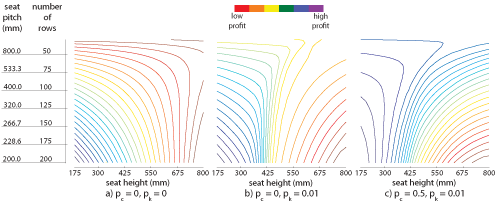Integrating the seemingly divergent objectives of aircraft seat configuration is a difficult task. Aircraft manufacturers look to design seats to maximize customer satisfaction and in-flight safety, but these objectives can conflict with the profit motive of airline companies. In order to boost revenue by increasing the number of passengers per aircraft, airline companies may increase seat height and decrease seat pitch. This results in disaccommodation of a greater percentage of the passenger population and is a reason for rising customer dissatisfaction.
This paper describes an effort to bridge this gap by incorporating digital human models, layout optimization, and a profit-maximizing constraint into the aircraft seat design problem. A simplified aircraft seat design experiment is conceptualized and its results are extrapolated to an airline passenger population. The dependence of passengers’ comfort ratings on seat height and seat pitch are analyzed, with the aim being to study how to maximize the design’s profitability while not compromising comfort. This is a specific example of a general problem: modeling the design space of multi-objective problems involving designing for human variability. These multiple and often conflicting objectives can exist purely within the de-sign (e.g., minimizing weight while maximizing strength) or can involve higher-level targets such as satisfying cus- tomers, passing regulatory requirements, and achieving profits (unfortunately these are not always congruent).

